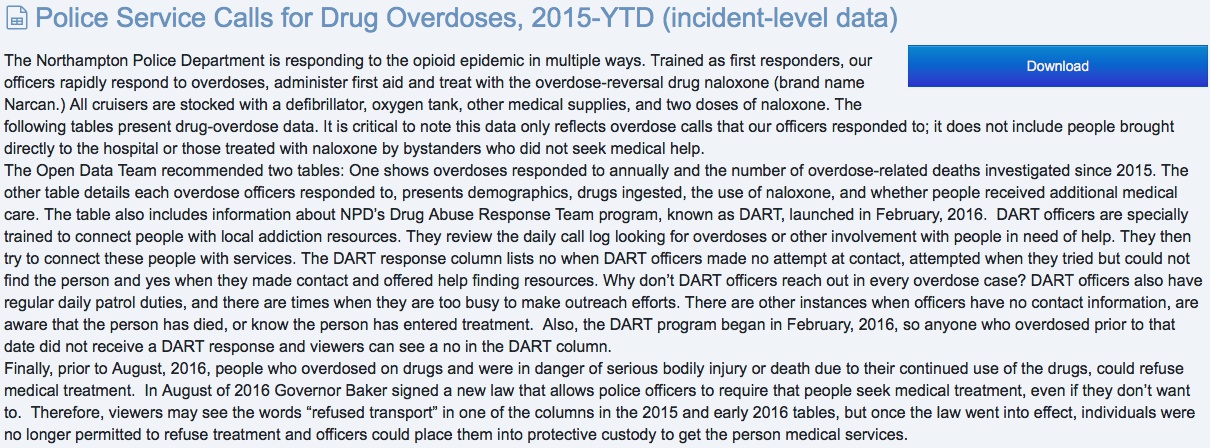Small Town, Big Ideas: Northampton’s No-Nonsense Approach Puts Citizen Engagement First

There’s no IT Department, no CIO and no dedicated funding for IT improvements. Like other smaller law enforcement agencies, the Northampton Police Department outsources its technology support and would seem to be an unlikely place for innovation around police open data. Chief Jody Kasper used her technological constraints to her advantage, starting with people first, and letting the tech and data follow. By engaging the public early, and often, Chief Kasper has not only reduced her organization’s risk, she is also collecting valuable input on what the community priorities are so she can deploy her agency’s limited resources in a way that will be most useful for the public, taking the concept of community policing to a whole new, digital level.
"Pulling back the blue curtain"
Chief Kasper sees transparency as a way to highlight the department’s high professional standards and progressive practices. She and her colleagues view the process of opening data as a means of building trust and legitimacy by "pulling back that blue curtain" and enabling open and free access to information on police activities
Before releasing a shred of data, she convened an Open Data Team made up of law enforcement officials, private citizens and members of the city government. Among the team members are Chief Kasper herself, a website designer, a journalist, a NPD community liaison officer, a city councilor, and others. By leading her data work with community engagement, Chief Kasper is able to answer some of the tough questions that police administrators face “openly and with certainty.”
An effective strategy to building trust with the community is for police to pull back that blue curtain, allowing open access to police information.
Chief Jody Kasper, Northampton Police Department
Public and police collaborating to select data sets
A key part of building data for the community was to involve them in the decision-making process all along the way, in the form of her Open Data Team. The next step for NPD was to figure out what data sets to prioritize, and how they should be released to the public. NPD has released 14 different data sets on a wide variety of topics ranging from major crime counts to descriptions of the community outreach activities being undertaken by NPD officers. In choosing what data to release, Chief Kasper felt it was far more important to release high quality data rather than providing high quantities of low quality data to the public. Chief Kasper and the Open Data Team also worked to ensure that the datasets chosen highlighted the positive efforts of the agency that are typically not the focus of media attention. Specifically, the NPD site hosts data on its community engagement efforts and the nature and extent of officer training. The training data reveals the NPD’s top training category of implicit bias and race relations and other topics that demonstrate how NPD is shifting training priorities to meet important needs and topics.
Publishing the data… with context
Another important step for NPD was creating a place on the department’s web site so the data would be easy to access. NPD's Open Data Portal can be accessed directly from the department's website and provides simple links to each of the available datasets as well as bios for each member of the Open Data Team.
The department also provides a paragraph of context for each data set. This enables public viewers to better understand where the data is coming from and often the degree of review the data has received by the Open Data Team. This additional information can be critical for explaining complicated policing issues to an unfamiliar public. For example, its drug overdose data page, NPD explains its “DART Officer” Program, saying that:
DART officers are specially trained to connect people with local addiction resources. They review the daily call log looking for overdoses or other involvement with people in need of help. They then try to connect these people with services.
By providing this context, NPD educates the public about drug overdoses in the community, the role of local policing, and how the data can be used to understand the agency’s response.


It can be done
The end result is a unique and helpful product for the citizens of Northampton to better understand the types of crimes in their area and how the police department is performing. In summary, Chief Kasper and the Northampton Police Department have demonstrated that it's possible for any agency, despite size and available resources, to leverage open data to not only demonstrate transparency, but to engage the community using facts supported by open data.
Post via: Police Foundation (@PoliceFound)
Top Photo Credit: Photo Courtesy Janel Jorda
The key steps leveraged in Northampton’s success can be recognized as:
If you liked this post, please share!
